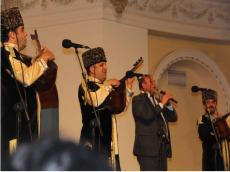|
|
TODAY.AZ / Arts & Entertainment
Azerbaijani ashiqs support National Army
08 October 2020 [16:27] - TODAY.AZ

By Azernews
By Laman Ismayilova
Representatives of ashiq art have provided support to national soldiers who are fighting on the frontline against Armenian invaders. Azerbaijani Union of Ashiqs transferred 1,000 AZN to Armed Forces Assistance Fund.
Armenian Armed Forces launched a large-scale military attack on positions of Azerbaijani army on the front line, using large-caliber weapons, mortars, and artillery on September 27.
Azerbaijan responded with a counter-offensive along the entire front. As a result, Azerbaijani Army liberated a number of territories previously occupied by Armenia, as well as took several strategic heights under control.
Speaking about the battles on frontline, Secretary of the Union, Honored Cultural Worker Musa Nabioghlu stressed that liberation of some territories aroused great joy and pride among ashiqs and increased the confidence that all Azerbaijani lands will soon liberated from Armenian occupation, Azertag reported.
Notably, Azerbaijan's Armed Forces Assistance Fund was established by the Decree of President Ilham Aliyev in 2002.
The Fund finances at the expense of funds received on a voluntary basis from legal entities and individuals operating in the territory of Azerbaijan and other receipts not prohibited by law for the purpose of financial assistance to strengthen the material, technical and social base of the Azerbaijan Armed Forces.
The art of Azerbaijani Ashiqs combines poetry, storytelling, dance and vocal and instrumental music into a traditional performance art.
Ashiq is frequently accompanied by traditional stringed musical instruments. The classical repertoire of ashiqs includes 200 songs, 150 literary-musical compositions known as dastans, nearly 2,000 poems in different traditional poetic forms and numerous stories.
Since 2009 the art of Azerbaijani Ashiqs has been inscribed on the Representative List of the Intangible Cultural Heritage of Humanity.
The history of Azerbaijan's Karabakh music is closely connected with the art of ashiqs, which brilliantly unites poetry, storytelling, dance, and vocal and instrumental music into traditional performance art.
Ashiq Valeh was one of the greatest representatives of ashiq art in Karabakh. Valeh was the stage name of the ashiq. His real name was Sefi. At a young age, Sefi became a student of ashiq Samed, who taught him the art of playing saz and poetry.
Over his life, ashiq Valeh delighted listeners with beautiful music pieces such as "Karabakh shikestesi", "Kesme shikeste", "Bash Saritel" and "Orta Saritel".
In general, Ashig Huseyn (1800-1880), Ashig Ali (1807-1917), Ashig Alasgar (1821-1926), Ashig Aziz (1825-1918), Ashig Mahammad (1834-1914), Molla Juma (1855-1919) and others left an incredible mark on Karabakh ashig art.
Karabakh also brought up the first female representative of this art-Ashig Pari. She was known as one of the pioneering women among ashiqs.
Since 2009 the art of Azerbaijani Ashiqs has been inscribed on the Representative List of the Intangible Cultural Heritage of Humanity.
URL: http://www.today.az/news/entertainment/198264.html
 Print version
Print version
Connect with us. Get latest news and updates.
See Also
- 12 August 2025 [17:16]
Institute of Archaeology and Anthropology publishes its first int'l periodical scientific journal - 12 August 2025 [16:41]
B-Boy Mahmood: Participants from over 20 countries to join first Baku Flow - 11 August 2025 [16:40]
Zeynal Khalil: Poet of heartfelt truth and enduring legacy - 10 August 2025 [11:35]
Azerbaijan marks 112th anniversary of people’s artist Kazim Kazimzade - 08 August 2025 [15:42]
Competition announced for State-Commissioned film projects for this year - 08 August 2025 [14:13]
Azerbaijan's national heritage presented in Turkmenistan - 08 August 2025 [13:36]
Garabagh University's scholar publishes monograph - 08 August 2025 [12:43]
ANAS granted full membership status by InterAcademy Partnership - 08 August 2025 [11:46]
Second stage of selection round underway within Children's Art Festival - 07 August 2025 [15:23]
Azerbaijan National Library pays tribute to People's Writer Elchin Afandiyev
Most Popular
 Iran rejects planned transit corridor outlined in Azerbaijan-Armenia pact
Iran rejects planned transit corridor outlined in Azerbaijan-Armenia pact
 India’s Russian oil lifeline under threat as Trump turns up heat
India’s Russian oil lifeline under threat as Trump turns up heat
 Serbia hails U.S.-brokered Azerbaijan–Armenia peace declaration
Serbia hails U.S.-brokered Azerbaijan–Armenia peace declaration
 Witkoff said to meet Qatari PM to discuss Gaza peace
Witkoff said to meet Qatari PM to discuss Gaza peace
 Armenian PM, Erdo?an discuss Washington agreements and regional cooperation in phone call
Armenian PM, Erdo?an discuss Washington agreements and regional cooperation in phone call
 Ministry of Emergency Situations continues fire safety awareness in liberated territories
Ministry of Emergency Situations continues fire safety awareness in liberated territories
 Nigerian troops ambush armed gang in northwest
Nigerian troops ambush armed gang in northwest
